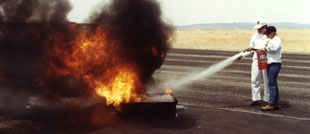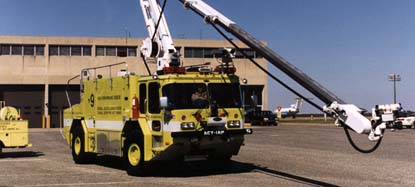
Product Information

Halotron™ I: Clean Fire Extinguishing Agent
Replacement for Halon 1211
Halotron™ I is a clean fire extinguishing agent intended
to replace halon 1211 in streaming applications. NFPA 2001, "Standard
on Clean Agent Fire Extinguishing Systems" defines a "Clean
Agent" to be "electrically nonconducting, volatile, or gaseous
fire extinguishant that does not leave a residue upon evaporation."
Halotron™ I is a safe, effective, environmentally acceptable replacement
for halon 1211. It is discharged as a liquid which rapidly evaporates (i.e.
it is volatile). It is a proprietary three component chemical blend based
on HCFC-123 that is approved by the U.S. EPA under its Significant New
Alternatives Policy (SNAP) program for commercial/industrial, military,
and maritime use in streaming applications as a substitute for halon 1211
(bromochlorodifluoromethane or "BCF").
The following are selected Halotron™ I approvals and listings:
There are other approvals not noted above which pertain
to specific countries in Eastern Europe, Asia, South America, and other
parts of the world. Please contact Halotron, Inc. for further information
on these approvals.
Application Areas for the Halotron™ I Fire
Extinguishing Agent
The application areas for Halotron™ I include Office Buildings, Retail and Wholesale Sales Facilities, Art Galleries, Automobiles, Short and Long Haul Trucks, Light and Medium Weight Delivery Vehicles, Warehouses, Computer Rooms, Manufacturing Plants, Clean Rooms (for computer chip manufacturing), Textile Plants, Laboratories, Heavy Machinery, Hazardous Material Storage Areas, Aircraft Engine Nacelles, Aircraft Flight Lines, On-Board Aircraft (portables), Aircraft Manufacturing, Aircraft Rescue and Fire Fighting (ARFF) Vehicles, Military Electronics Facilities, Military Training, Commercial Vessels, Yachts, Pleasure Boats, Ship Control Rooms, Ship Engine Rooms, Passenger Crew Areas, Conventional and Nuclear Generation Plants, Transmission Facilities, Telecommunications Facilities, Railroad Equipment, Auto Racing, Libraries, FAA Control Towers, and Spacecraft Facilities.
US EPA Significant New Alternatives Policy (SNAP) Program
The stated objective of the US EPA Significant New Alternatives Policy (SNAP) program is to evaluate proposed substitutes for ozone depleting substances, including CFCs and halons, in a variety of end uses for effects on human health and the environment and to characterize them as either acceptable or unacceptable. The SNAP rule was initially outlined by EPA in 1992. In the final SNAP rule, published in the Federal Register on March 18, 1994, Halotron™ I (or "HCFC Blend B" in the rule) was listed as an acceptable streaming agent substitute for halon 1211 in commercial/industrial, maritime, and military uses. The EPA updates the SNAP list periodically and has done so several times since March, 1994.
US Federal Aviation Administration (FAA) Test Program for Airport Fire Fighting

A full-scale fire test evaluation sponsored by the FAA
commenced at Tyndall Air Force Base, Florida in March, 1993. The program
was initially designed to measure the fire fighting performance of Halotron™
I and perfluorohexane relative to halon 1211 in a series of fire tests
that included three dimensional running fuel fires, jet wheel brake fires,
pool fires, and agent throw range fires. The following briefly describes
those tests:
All tests were conducted with a wheeled 150 lb. (68 kg)
type fire extinguisher. The test program evolved over time to include active
participation of the US Air Force. In addition, a 500 lb. (227 kg) type
unit, of the same type used on aircraft rescue and fire fighting (ARFF)
vehicles was used on some of the events in the latter stages of the test
program. This FAA sponsored series of tests was intended to simulate the
types of fires encountered by aircraft flight line fire fighting personnel.

U.S. FAA Approval for Airport Fire Fighting
On June 12, 1995, the FAA issued CertAlert 95-03, which describes the approval of Halotron™ I for use in airport fire fighting. The primary application for Halotron™ I at commercial airports has been in aircraft rescue and fire fighting (ARFF) vehicles. Copies of this CertAlert are available upon request. As of June, 1997, Halotron™ I is in use in more than 12 international airports.
Other Halotron™ I Testing and Approvals
Development in Sweden
Initial development of Halotron™ I occurred in Sweden
at the University of Lund and the Swedish National Testing and Research
Institute. The work at the University of Lund was on a laboratory scale
and the work at the Swedish National Testing and Research Institute involved
indoor fire tests.
New Mexico Engineering Research Institute
An initial evaluation of Halotron™ I in the US occurred
at the New Mexico Engineering Research Institute (NMERI) in early 1992.
The full scale outdoor tests included a toxicity screening and full scale
fire tests with JP-4 jet fuel. These fire tests involved round pans and
three dimensional running fuel fires. Hand held portable and wheeled fire
extinguishers were used in these tests.
US Navy Sponsored Tests at the US Marine Corps Air Station at Beaufort, South Carolina USA
The US Navy sponsored a series of full scale fire tests at the Marine Corps Air Station (MCAS) at Beaufort, South Carolina, USA in October, 1992. The test series consisted of four different types of tests intended to simulate aircraft-related fires, commonly encountered by flight line fire fighting personnel, where halon 1211 has been used in the past. A US EPA contractor was present who coordinated fire fighter exposure by monitoring for potential unhealthful gas exposures. None were found. Other US DOD representatives were also present. All tests used JP-5 jet fuel.
The test events included a pan fire, two jet engine fire simulations (including a running fuel fire), and a large pool fire. For each type of test, halon 1211 was tested twice, followed by four tests with Halotron™ I. The Marine Corps report issued in November, 1992, stated that using data based on typical incidents involving fire in US DOD flight line operations, and on the performance of Halotron™ I relative to halon 1211, the number of existing halon 1211 fire extinguishers in the field would not need to be increased in order to use Halotron™ I. In addition, the report states that Halotron™ I is suitable for combatting aircraft fires.
Underwriters Laboratories, Inc./UL Canada Listing in Portable Fire Extinguishers
A full test program was initiated in 1995 with Underwriters
Laboratories, Inc. (UL) and UL of Canada (ULC) for listing Halotron ™ I
in portable extinguishers. This test program was conducted in compliance
with ANSI/UL 711 and ANSI/UL 1093. The extinguishers were tested for the
following fire classes:
The initial UL and ULC listings were achieved by Buckeye Fire Equipment Company in early 1996. Initial charge amounts for specific ratings have been reduced over time. The initial charge amounts are still available and offer the user, if desired, extra agent capacity. The following are current UL and ULC listings. Please contact Buckeye Fire Equipment Company or Amerex Corporation for more information.
| UL Rating | Charge Amount | ULC Rating | Charge Amount | |
| 1-B:C (Amerex only) |
1.4 lbs. (0.64 kg) Fixed Nozzle | |||
| 2-B:C | 2.5 lbs. (1.13 kg) Hose/Nozzle and Fixed Nozzles | 2-B:C | 2.5 lbs. (1.13 kg) Fixed Nozzle | |
| 5-B:C | 5.0 lbs. (2.27 kg) Fixed Nozzle | 5-B:C | 5.5 lbs. (2.5 kg) Hose/Nozzle | |
| 5-B:C | 5.5 lbs. (2.5 kg) Hose/Nozzle | 1-A:10-B:C | 11 lbs. (5.0 kg) Hose/Nozzle | |
| 1-A:10-B:C | 11 lbs. (5.0 kg) Hose/Nozzle | 2-A:10-B:C | 15.0 lbs. (6.8 kg) Hose/Nozzle | |
| 2-A:10-B:C | 15.5 lbs. (7.03 kg) Hose/Nozzle |
UL Component Recognition
Halotron™ I is component recognized by UL in the Clean Agents for Fire Extinguishers and Extinguishing System Units category. The file number is EX5107 (N).
US Coast Guard Approval
Halotron ™ I is approved by the US Coast Guard. UL listed portables that comply with performance and hardware test requirements are authorized to be marked "Marine Type, USCG Approved." The following minimum agent weights and categories apply:
NFPA 10 Tentative Interim Amendment
Halotron™ I is incorporated into NFPA 10, Standard for
Portable Fire Extinguishers, by way of Tentative Interim Amendment (TIA)
94-2. This amendment revises the definition of "Halogenated"
Agents in NFPA 10 to include "Halocarbons" including HCFCs.
Halotron™ I Physical Data
|
|
|
| PROPERTY | HALOTRON™ I |
| Chemical Formula (1) | C2HCl2F3 (HCFC-123) + Prop. Gas Mixture |
| Ozone Depletion Potential (ODP) (CFC-11 = 1.0) |
0.014 |
| Global Warming Potential (GWP) (2) (100 year CO2 based ITH) |
140 to 840
0.04 to 0.24 (CFC-11=1.0) |
| Atmospheric Lifetime in Years (2) | 3.5 to 11 |
| Molecular Weight | 150.7 |
| Boiling Point (3) | 80.6 °F (27 °C) |
| Liquid Density at 25 °C | 92.3 lb/ft3 (1.48 kg/l) |
| Vapor Pressure at 25 °C (4) | 95 psi (6.55 bar) |
| Extinguishing Concentration: n-heptane Cup Burner |
6-7 % by vol. |
| Acute Toxicity: Cardiotox LOAEL (5) (Lowest Observed Adverse Effect Level) |
2% |
| Acute Toxicity: Cardiotox NOAEL (5) (No Observed Adverse Effect Level) |
1% |
| Acute Toxicity: ALC, LC50 (4 hours) | >3% |
|
|
HCFC Phase-Out Issue
As stated previously, Halotron™ I is based on HCFC-123. HCFC-123 has a non-zero ozone depletion potential of 0.016 (CFC-11 = 1.0). It is considered a "transitional substance" under the Montreal Protocol and the Clean Air Act Amendments (CAA) of 1990. "Consumption" in the Montreal Protocol and CAA is defined to be production, plus imports, minus exports, minus feedstock. The Montreal Protocol and CAA require consumption limits on newly manufactured materials based on the baseline year of 1989. The baseline amount for each country is calculated to be 2.8% of ozone depletion potential (ODP) weighted CFC consumption plus the ODP weighted HCFC consumption. HCFC-123 is widely used in the refrigeration sector as a replacement for CFC-11, and therefore, is produced at levels that are quite high. The relative production for fire fighting purposes (including Halotron™ I) has been estimated to be less than 1%. The consumption cap reduction is 35% on January 1, 2004; 65% on January 1, 2010; 90% on January 1, 2015; 99.5% on January 1, 2020; and 100% on January 1, 2030. The consumption cap does not restrict the use of existing Halotron™ I extinguishers and does not restrict the use of recycled materials. The time period of availability of Halotron™ I for new fire extinguishers and servicing existing fire extinguishers is expected to go beyond the year 2030. For more information on this issue, please see the publication that is available in the Technical Information section.
Halotron™ II: Replacement for Halon 1301
Halotron™ II is a clean fire extinguishing agent intended to replace halon 1301 for normally unoccupied areas. Halotron™ II has been tested extensively for fire fighting performance. It is currently listed as "pending" on the US EPA SNAP list.
Halotron™ II Physical Data
|
|
|
| PROPERTY | Halotron™ II |
| CHEMICAL IDENTITY | Proprietary HFC Blend |
| OZONE DEPLETION POTENTIAL (CFC-11=1.0) | 0 |
| GLOBAL WARMING POTENTIAL (1) | 2,975 0.85 (CFC-11 = 1.0) |
| ATMOSPHERIC LIFETIME | Approximately 326.5 years |
| MOLECULAR WEIGHT | 102.16 |
| BOILING POINT | -78.5 °C to -26.3 °C |
| FREEZING POINT | -101 °C to -50.7 °C |
| CRITICAL TEMPERATURE | 86 o C |
| CRITICAL PRESSURE | 43.7 bar |
| CRITICAL DENSITY | 563 kg/m3 |
| LIQUID DENSITY @ 20 °C | 1.21 kg/L |
| VAPOR PRESSURE @ 20 °C | 15.19 bar |
| NOAEL, CARDIAC SENSITIZATION | > 4 % by volume |
| LOAEL, CARDIAC SENSITIZATION | > 8 % by volume |
| LC 50 (4 HRS.) | > 500,000 ppm |
| CUP BURNER CONCENTRATION (2) | 9 % by volume |
| 1 - BASED ON 100 YEAR INTEGRATION
TIME HORIZON (ITH) 2 - NMERI 5/8 CUP BURNER, HEPTANE |
|
© Halotron, Inc. 1997. All Rights Reserved. Retransmission, reproduction or distribution without express written consent of Halotron, Incorporated is prohibited. Halotron and the Halotron logo are registered trademarks of Halotron, Incorporated.